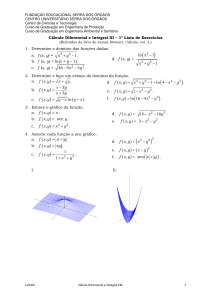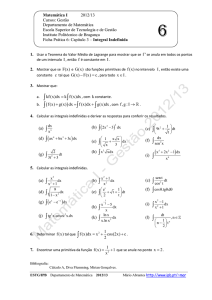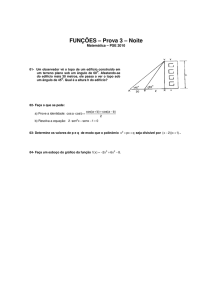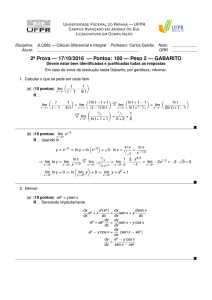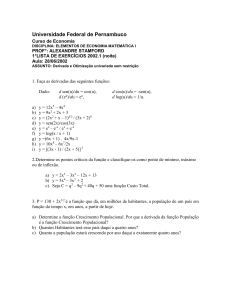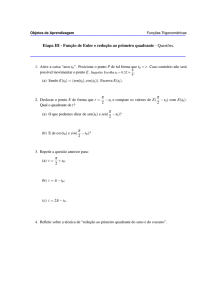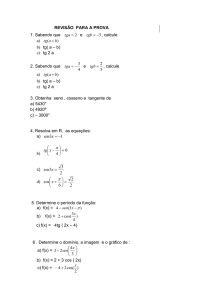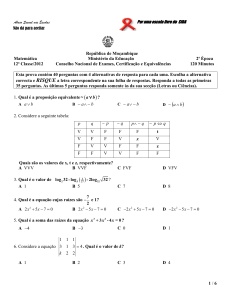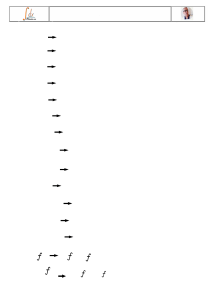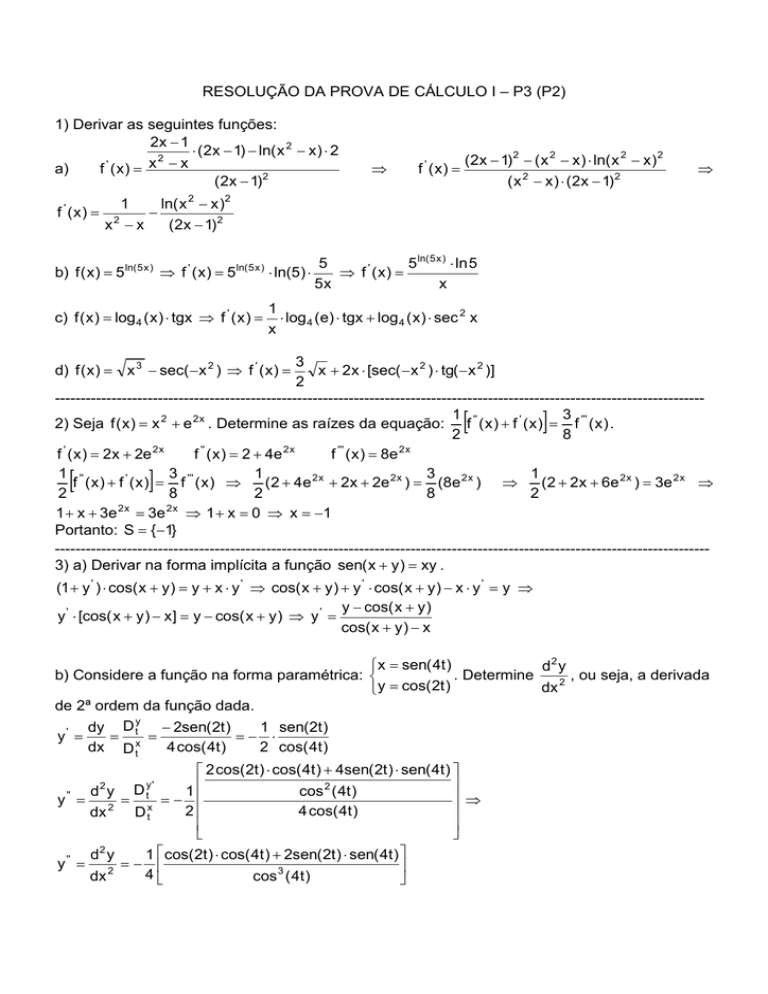
RESOLUÇÃO DA PROVA DE CÁLCULO I – P3 (P2)
1) Derivar as seguintes funções:
2x − 1
⋅ (2x − 1) − ln( x 2 − x ) ⋅ 2
2
a)
f ' ( x) = x − x
(2x − 1)2
1
'
f (x) =
x2 − x
−
⇒
f ' ( x) =
(2x − 1) 2 − ( x 2 − x ) ⋅ ln( x 2 − x ) 2
( x 2 − x ) ⋅ (2x − 1) 2
⇒
ln( x 2 − x )2
(2x − 1) 2
b) f ( x ) = 5 ln( 5 x ) ⇒ f ' ( x ) = 5 ln( 5 x ) ⋅ ln(5) ⋅
c) f ( x ) = log 4 ( x ) ⋅ tgx ⇒ f ' ( x ) =
5
5 ln( 5 x ) ⋅ ln 5
⇒ f ' ( x) =
5x
x
1
⋅ log 4 (e) ⋅ tgx + log 4 ( x ) ⋅ sec 2 x
x
3
x + 2x ⋅ [sec( − x 2 ) ⋅ tg( − x 2 )]
2
-----------------------------------------------------------------------------------------------------------------------------1
3
2) Seja f ( x ) = x 2 + e 2 x . Determine as raízes da equação: f '' ( x ) + f ' ( x ) = f ''' ( x ) .
2
8
'
2x
''
2x
'''
2x
f ( x ) = 2x + 2e
f ( x ) = 2 + 4e
f ( x ) = 8e
1 ''
3
1
3
1
f ( x ) + f ' ( x ) = f ''' ( x ) ⇒
(2 + 4e 2 x + 2x + 2e 2 x ) = (8e 2 x ) ⇒
( 2 + 2 x + 6 e 2 x ) = 3e 2 x ⇒
2
8
2
8
2
2x
2x
1 + x + 3e = 3e ⇒ 1 + x = 0 ⇒ x = −1
Portanto: S = {−1}
------------------------------------------------------------------------------------------------------------------------------3) a) Derivar na forma implícita a função sen( x + y ) = xy .
d) f ( x ) = x 3 − sec( − x 2 ) ⇒ f ' ( x ) =
[
[
]
]
(1 + y ' ) ⋅ cos( x + y ) = y + x ⋅ y ' ⇒ cos( x + y ) + y ' ⋅ cos( x + y ) − x ⋅ y ' = y ⇒
y − cos( x + y )
y ' ⋅ [cos( x + y ) − x ] = y − cos( x + y ) ⇒ y ' =
cos( x + y ) − x
x = sen( 4t )
d2 y
b) Considere a função na forma paramétrica:
. Determine
, ou seja, a derivada
dx 2
y = cos( 2t )
de 2ª ordem da função dada.
y
dy D t
− 2sen(2t )
1 sen(2t )
y' =
= x =
=− ⋅
dx D t
4 cos( 4t )
2 cos( 4t )
2
y '' =
y '' =
d y
dx 2
d2 y
dx 2
2 cos( 2t ) ⋅ cos( 4t ) + 4sen(2t ) ⋅ sen( 4t )
1
cos 2 ( 4t )
⇒
=
=−
2
4 cos( 4t )
1 cos( 2t ) ⋅ cos( 4t ) + 2sen(2t ) ⋅ sen( 4t )
=−
4
cos 3 ( 4t )
D ty '
D tx
4) Resolver os limites usando a Regra de L’Hospital.
x −2
= 00
a) Lim (2x − 4 )
x →2
Fazendo f ( x ) = (2x − 4) x −2 e passando o ln: ln f ( x ) = ln( 2x − 4) x −2 ⇒ ln f ( x ) = ( x − 2) ⋅ ln( 2x − 4) .
Passando o limite: Lim[ln f ( x )] = Lim[( x − 2) ⋅ ln(2x − 4)] = 0 ⋅ ( −∞ )
x →2
x →2
ln( 2x − 4) − ∞
. Podemos aplical L’Hospital:
Lim[ln f ( x )] = Lim
=
x →2
x →2
1
∞
x − 2
2
ln( 2x − 4)
2x − 4
lnLim f ( x ) = Lim
= Lim
x →2
x→2
1
x →2 − 1
( x − 2) 2
x − 2
2
1
2( x − 2)
( x − 2)
= Lim
= Lim
x → 2 − 1 x →2 − 1
( x − 2) 2
( x − 2) 2
2
= Lim − ( x − 2)
x →2 x − 2
⇒ lnLim f ( x ) = Lim[− ( x − 2)] = 0 ⇒ Lim f ( x ) = e 0 = 1
x →2
x→2
x →2
Portanto: Lim (2x − 4 )
x →2
x −2
=1
e x2 − 1 0
= . Podemos aplicar L’Hospital:
b) Lim
x →0 cos x − 1
0
e x2 − 1
2x ⋅ e x 2 0
= . Podemos derivar novamente:
Lim
= Lim
x →0 cos x − 1
x →0 − senx
0
e x2 − 1
2x ⋅ e x 2
2 ⋅ e x 2 + 2x ⋅ 2x ⋅ e x 2
e x 2 ⋅ ( 2 + 4 x 2 ) e 02 ⋅ ( 2 + 4 ⋅ 0 2 )
=
Lim
= Lim
= Lim
= Lim
= −2
x →0 cos x − 1
x →0 − senx
x →0
x
0
→
− cos x
− cos x
− cos 0
2
ex − 1
= −2
Portanto, Lim
x →0 cos x − 1
------------------------------------------------------------------------------------------------------------------------------5) Fazer um estudo completo e esboçar o gráfico da função f ( x ) = − x 3 + 3 x + 4 .
Domínio da f(x) são os reais, ou seja: D( f ) = ℜ
Para esta função não é muito fácil determinar as raízes.
Para x=0 em f(x) ⇒ f (0) = 4 , logo a f corta o eixo Ou em (0,4).
Derivadas: f ' ( x ) = −3 x 2 + 3 e f '' ( x ) = −6 x
Pontos críticos: f ' ( x ) = −3 x 2 + 3 = 0 ⇒ x 2 = 1 ⇒ x1 = 1 e x 2 = −1
Máximos e Mínimos:
''
f (1) = −6 ⋅ 1 = −6 ⇒ f '' (1) < 0 (ponto de máximo)
Fazendo x1 = 1 na f(x): f (1) = −13 + 3 ⋅ 1 + 4 = 6 ⇒ (1,6) é Ponto de Máximo da f(x).
f '' ( −1) = −6 ⋅ ( −1) = +6 ⇒ f '' ( −1) > 0 (ponto de mínimo)
Fazendo x 2 = −1 na f(x): f ( −1) = −( −1)3 + 3 ⋅ ( −1) + 4 = 2 ⇒ (-1,2) é Ponto de Mínimo da f(x).
Crescimento e decrescimento:
Analisando o sinal da f ' ( x ) = −3 x 2 + 3 :
( −∞,−1] : Decrescente
(−1, 1) : Crescente
[1,+∞) : Decrescente
–
–1
+
1
–
Ponto de Inflexão: f '' ( x ) = −6 x = 0 ⇒ x = 0
Fazendo x = 0 na f(x): f (0) = −(0)3 + 3 ⋅ 0 + 4 = 4 ⇒ (0,4) é Ponto de Inflexão da f(x).
Concavidade:
Analisando o sinal da f '' ( x ) = −6 x
+
0
–
(−∞,0] : Côncava para cima
(0,+∞ ) : Côncava para baixo

